Just want to give a shout out to the CapFriendly team for all their work over the last decade. The site went dark yesterday after being bought by the Washington Capitals. It was such an invaluable resource for all of us here at Dobber Hockey that it's one of those things you don't notice how much you rely on it until it's gone. Thank you for all the efforts of the group over the years, and good luck to them in their new chapter with the Capitals.
Also, now is a good time to shout out PuckPedia, who seem to the heir apparent in this salary cap arena.
*
In Tuesday's Ramblings, there were a number of smaller signings discussed and one of them was Flyers defenceman Egor Zamula. At the time, I said that he was one of the more interesting deep-ish defence targets that caught my eye. That was until Tuesday, anyway, when the Florida Panthers announced they were signing Adam Boqvist to a one-year contract. A handful of injuries limited Boqvist to just 35 games in 2023-24 where he totaled 10 points. Boqvist turns 24 years old later this summer and has 209 regular season games across five seasons to his name.
Boqvist is one of those players that has long been interesting to me because of what he does on the ice. His 85 points in 209 games might not scream 'big point producer' but he's done that skating 17:26 per game. His 1.38 points per 60 minutes of total game time over his five seasons is a 78th percentile mark in the league (minimum of 3000 minutes) and higher than names like Jared Spurgeon, Noah Hanifin, and Seth Jones. It isn't just power play production, either, as his 1.07 points per 60 minutes at 5-on-5 over his career is an 81st percentile mark, and higher than names like Josh Morrissey, Miro Heiskanen, and Torey Krug. He has just been a very good (not great) point producer.
However, Boqvist is now going to be on his third team in six seasons by his age-24 campaign. The reason for that is his defence has been horrific, and NHL coaches just will not put up with awful defensive play without superlative offensive performance; just being very good isn't enough. From Evolving Hockey, here are his offensive and defensive impacts over the last three seasons alone:
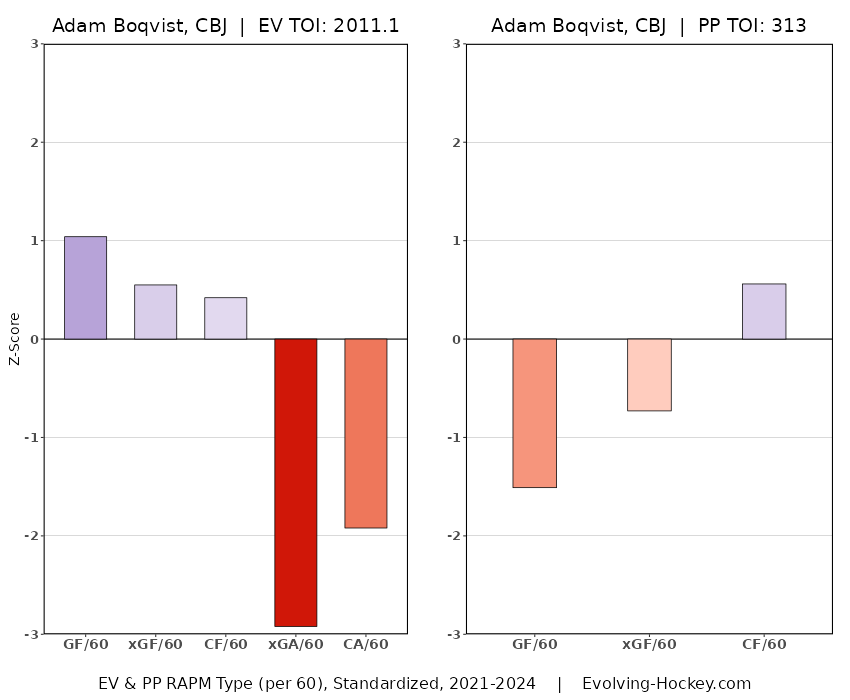
That giant red line is his expected goals against impact. In short: it's real bad.
There are two questions that we need to ask when looking at this type of player: have players like this become good, impactful NHLers before, and if things turn around, can he be impactful enough to help in the fantasy realm?
First, we need to determine what kind of player that Boqvist is. We will use his last three seasons as the basis, so these are the parameters:
- Defenceman between the ages of 20 and 23.
- At least 2000 minutes of even strength play.
- Very poor defensive impact at even strength leading to poor goals against numbers.
- A very good-but-not-elite goals-for impacts on his team.
When looking at the 2017-2020 seasons to see if anyone fits that bill, one name came up:

Aside from Thomas Chabot, there were some players who fit a few parameters. Some of the worse defensive impacts came from Tony DeAngelo (and we know how that's gone) as well as Zach Werenski (who could be a top-20 defenceman in fantasy drafts this September). There were also Robert Hagg and Rasmus Ristolainen, but they didn't have the goals-for or expected goals-for components necessary. What separated DeAngelo and Werenski from Boqvist were that actual goals against numbers weren't as bad as Boqvist's were. It left us with Chabot.
One complicating factor is that Boqvist is 6'0" whereas both Werenski and Chabot are 6'2". Assuming equal-ish skills, the latter two names would have an easier time defensively because of the additional size and reach.
The important note here is that neither Chabot nor Werenski has turned into a reliable defensive defenceman. Injuries aside, Chabot has lost over three minutes in ice time per game over the last two seasons as Ottawa's blue line got deeper. Both Chabot and Werenski became high-end drivers of both goals and expected goals for their teams, and that helps out-weigh the defensive issues. However, whatever else they are, neither is a good defensive defenceman.
This brings us back to Boqvist. Back in 2022-23, tracking data from AllThreeZones had Boqvist as above average by scoring chances at 5-on-5 and assists on teammate chances at 5-on-5. In fact, he was similar to the aforementioned Hanifin as well as another blue liner that took years for his puck skills to become honed enough to be an impact fantasy producer in Vince Dunn (red circle):
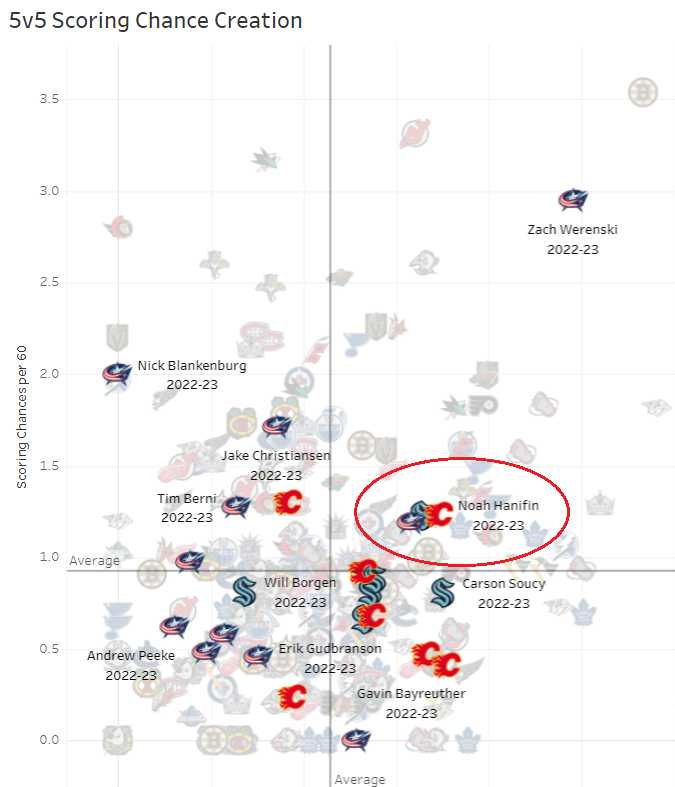
In that same season, he was also one of two Columbus defencemen (again with Werenski) to be above average by both zone entries per 60 minutes at 5-on-5, and the rate at which he carried the puck into the zone. He did so at a rate comparable to Jaccob Slavin and Travis Sanheim:

Funny enough, back in 2021-22, Boqvist had a nearly identical 60-minute zone entry rate (7.23) as former Florida Panther reclamation project Brandon Montour (7.19). Boqvist had a much higher carry-in rate, too.
The 2023-24 season was not a good one for our subject, but between his injuries and that of the entire Columbus roster, there may have been something else at work here. He has long struggled in the defensive zone, but has generally done well enough offensively to be close to an average defenceman by goals for/against differential. To that end, it should be noted that at 5-on-5 from 2021-2024, Columbus had a -13 goal differential in Boqvist's 1967:43 of ice time. Put another way, Columbus went minus-1 in every 151.4 minutes of Boqvist's 5-on-5 ice time. When he was off the ice in those three seasons, the team went minus-1 every 75.8 minutes.
In simpler terms: over the last three seasons at 5-on-5, Columbus went minus-2 in the same amount of time it took Boqvist to go minus-1. If the object of the game is to finish three periods with more goals than the other team, maybe he wasn't the biggest problem.
This isn't to absolve Boqvist of his defensive issues. There are a lot of those, particularly when it comes to defending the blue line from opponent zone entries. It is to say that we have seen issues like this before and some of those players went on to become not only NHL regulars, but impactful fantasy players.
Florida still has Aaron Ekblad and Gustav Forsling to contend with for top power play time. It is notable that when the team took Montour off the top power play in the Stanley Cup Final, it was Oliver Ekman-Larsson, and not Ekblad or Forsling, that took the top power play minutes. It seems coach Paul Maurice didn't want to rely on those defensive stalwarts for the power play, and would rather save them for the shift immediately following the power play, whether a goal was scored or not. That type of mentality plays to Boqvist's favour.
There are injury issues (particularly concussions, which is not good), there are defensive issues, and there are potential road blocks to top power play time. However, Boqvist has been a good point producer in the time he's been given, and he may be brought in to run the power play unit for the reigning Cup champions. At the least, he should be given the chance to do so. When it comes to fantasy drafts in September, we can do a lot worse than a late-round flier on a player with this kind of profile. He won't bring much for peripherals, so he's a lot more valuable in points-only formats than multi-cat ones, but on a very cheap contract, he'll play well in any type of salary cap league. There will be worse bets made during the later rounds of fantasy drafts in September, I feel certain of that much.
*
I was looking over the Anaheim Ducks roster, and this seems like a giant headache for fantasy purposes, right? For returning players, we have Troy Terry, Alex Killorn, Ryan Strome, Frank Vatrano, Mason McTavish, and Leo Carlsson. It seems like Cutter Gauthier is on the roster in October, too, while they also traded for Robby Fabbri. That makes eight forwards precluding any further signings or trades, or any prospects, that could all slot into the top three lines. That could be the difference between playing 15:30 a night with secondary power play time or 18 minutes a night with top power play time.
We will do our best to sort this out in the 2024 Dobber Hockey Draft Guide (available for pre-order now), and my guess is that at least Terry and Carlsson will get the meat of the minutes, but this does seem a headache elsewhere. It isn't hard to see Zegras getting 16 minutes a night if he doesn't bounce back well, or 18 minutes a night if he does. Maybe they stuff Gauthier on the third line with McTavish to try and hide them a bit from tougher competition, or maybe Gauthier is a Rookie of the Year candidate (non-Michkov/Celebrini category) and he goes right to the top-6 with a premiere PP role. Let's wait to see where ADPs fall, but for a team on the rise, there may not be as much consistent fantasy value as we'd like.
*
One of the few remaining RFAs to sign is Dawson Mercer. Not that there should be a problem getting him at least a two-year bridge deal, but it just reminded me how far he is from having real fantasy impact. All of Timo Meier, Jack Hughes, Jesper Bratt, and Nico Hischier are signed for at least three more seasons, and the first three names are signed through to 2030 or beyond. If Mercer really wants to maximize his earnings, is he in the right spot to do it? He will not be earning consistent top power play minutes anytime soon, especially if New Jersey decides to use Ondrej Palat as a sometimes-replacement. That also precludes any other additions or prospects to come. Would Mercer ever ask for a trade? It's just me thinking out loud, but something I'll keep an eye on this summer (and for the next couple offseasons).


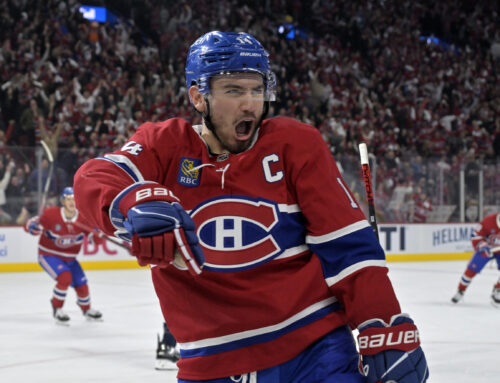
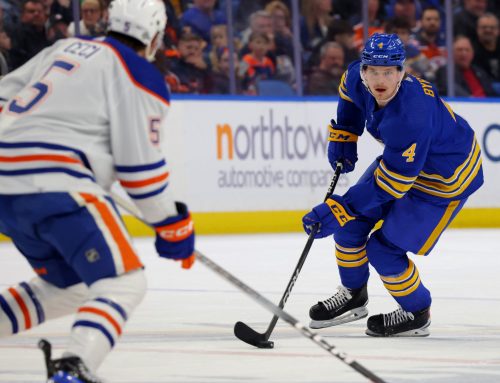
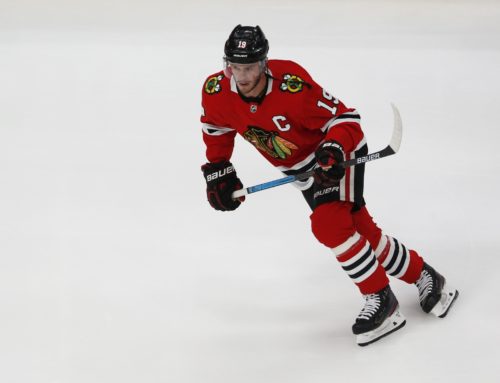
 BUF
BUF NYR
NYR CHI
CHI WSH
WSH CBJ
CBJ VAN
VAN S.J
S.J PIT
PIT L.A
L.A
